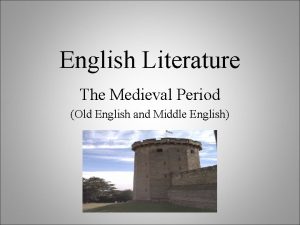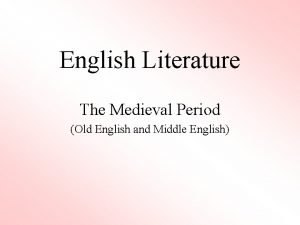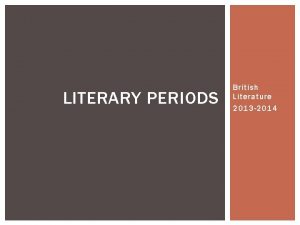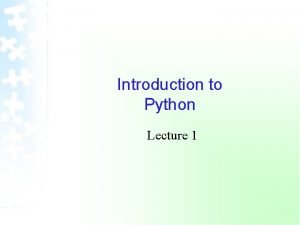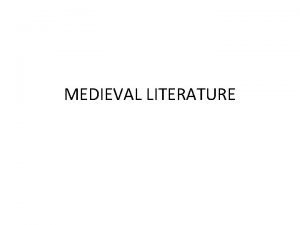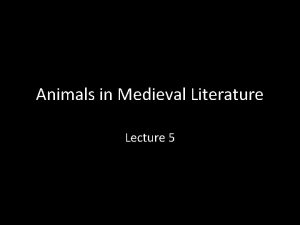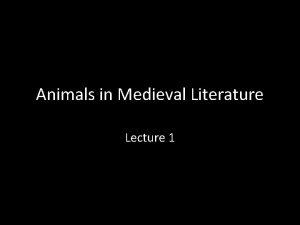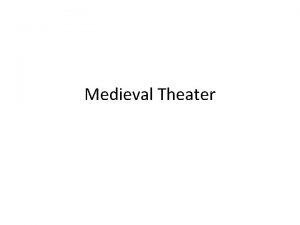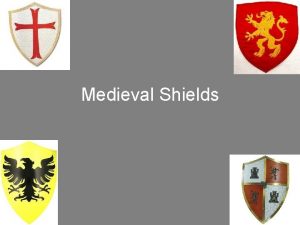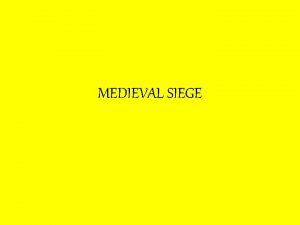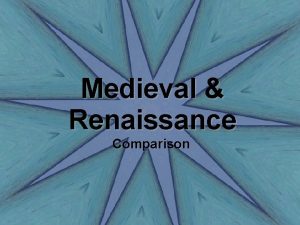Animals in Medieval Literature Lecture 4 Language Animals













- Slides: 13

Animals in Medieval Literature Lecture 4

Language • Animals as non-linguistic creatures • Jacobus de Vorgaine, Legenda aurea: – 5 categories of creatures of which only man speaks – Speech = mark of superiority/lack • Animal speech often a result of divine or diabolical intervention – Book of Numbers 22. 21 -35: Balaam’s ass

Balaam’s Ass Français 152, fol. 78 v

Language in Fables/ the Renart • In the fable tradition animal speech is less surprising? • Animal speech = part of broader parodic and satirical framing of text • Roman de Renart similarly takes animal speech for granted • Renart’s discourse associated with hunger? ‘Le texte renardien ne nourrit pas: la gueule, l’estomac creux, le désir continuent à béer. La logophagie renardienne, contrairement à sa conception traditionelle, ne nourrit pas son homme. ’ (Scheidegger, pp. 221 -2)

The Renart and Historical Debates about Language • French = one of the most widely used vernaculars in medieval Western Europe • From the late 12 th c. French identified with the French royal court was increasingly seen as a model of literary expression – Guernes de Pont-Sainte-Maxence – Marie de France – Aimon de Varennes

‘Franco-English jargon’ Texts • Not accurate witnesses of real cultural and linguistic contact • Anglicized French = a mixture of different inaccuracies • Comment on the attempt to lay claim to French as an international language identified with French monarchy? • Undermine any notion of French as a single, unified language (Ardis Butterfield)

‘Franco-English jargon’ Texts • Renart teinturier/Renart jongleur episodes use anglicized French as part of a disguise • Renart’s anglicized speech = parody of English • Renart’s linguistic control relies on performance of the imperfect command of French by the nonnative speaker • Renart’s anglois (English) = a form of French • What is perceived as linguistic difference = the performance of stereotypes of difference


Renart, vv. 2403 -2416 - Godehere, fait il, bel sir, Ne sai rien de ton raison dir. - Et Diex vos saut, fait il, amis, Dom estes vos? de quel païs ? Vos ne futes pas nez de France Ne de la nostre connoissance. - Naie, seignor, mes de Bretaing, S’avra tot perdu mon gaaing Et fot cerchié par men conpaing, Ne trover neant que m’ansaing. Toute France et tote Angleter Fout cerchié por mon conpaing quer ; Si voil Paris torner ainçois, Tant avrai mout bien pris françois. - Godsavyers! he said, dear sir, Me not know nothing of your meaning. - May God keep you my friend, he said, Where are you from? From which country? You were not born in France Or any other country we’ve heard of. - Nay, my lord, but from Britaing, Me will have lost all that I gaigned And me **** looked for my compaingon Me not found nothing to me inform. All France and all England **** looked to seek my compaignon; Next me wants to before turn to Paris So me shall very good learn French.

Renart, vv. 2465 -2477 Renart tenoit le chief anclin: - Par foi, fait il, dant Isangrin, mauvés lecher fout il desvez ; comment fout il donques pelez ? dites moi conment il a non fout il dont apelez anon ? Isangrin rit, qant celui ot, Et por le non d’Anon s’esjot. Mout l’amast il ja a savoir. - Oïl ver, con fout il pelez ? - Renart ot non li desfaez qui grant honte et dolor nos maine. Renart kept his head lowered : - by my faith, he said, lord Ysengrin, Bad scoundrel he **** crazy; How **** he then call’d? Tell me how he’s named (a non) **** he then called a name (Anon)? Ysengrin laughs when he hears this, Tickled on account of the name ‘Anon’. He certainly really liked knowing this one. - Yes, truly, how **** he call’d? - Renart is the name of the scoundrel who causes us great shame and suffering.

The Renart and Language • Roman de Renart brings to the fore the artificial qualities of Franco-English jargon • Renart’s speech opens gap between language, origin, and ethnicity • Complicates question of language: not just about human/animal attributes • Animal language part of parody of linguistic tensions between England France • Parody doesn’t simply reaffirm the superiority of the native speaker of French

References • Ardis Butterfield, The Familiar Enemy: Chaucer, Language, and Nation in the Hundred Years War (2009) • E. Schulze-Busacker, ‘Renart, le jongleur étranger : analyse thématique et linguistique à partir de la branche Ib du Roman de Renart (vv. 2043 -2580 et 2857 -3034)’, in Proceedings of the Third International Beast Epic, Fable and Fabliau Colloquium (Münster, 1979), ed. Jan Goossens and Timothy Sodmann, Niederdeutsche Studien, 30 (1981), pp. 380 -91

Seminar • How would you characterise Renart’s trickery in the last 3 sections of the text? How do his tricks compare with those in earlier sections of the work? Are there any differences that you notice? • Analyse the role of disguise in these later parts of the text. How might this connect with 1) earlier episodes of Branch I and 2) other depictions of the fox in medieval sources (e. g. bestiaries and fables)? • Have a look at the illuminations accompanying the Renart teinturier/Renart jongleur scenes in Paris Bn. F, MS fr. 12584. How might these images comment on the text?
 01:640:244 lecture notes - lecture 15: plat, idah, farad
01:640:244 lecture notes - lecture 15: plat, idah, farad British literature notes
British literature notes Characteristics of medieval english literature
Characteristics of medieval english literature Characteristics of medieval period in english literature
Characteristics of medieval period in english literature Early modern period dates
Early modern period dates Medieval romance literature characteristics
Medieval romance literature characteristics English literature lecture
English literature lecture Https//a-z-animals.com
Https//a-z-animals.com Are bears producers or consumers
Are bears producers or consumers Animals that eat both plants and animals
Animals that eat both plants and animals Carnivore
Carnivore Natural language processing
Natural language processing Natural language processing lecture notes
Natural language processing lecture notes Big picture lecture language
Big picture lecture language


